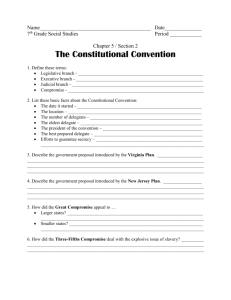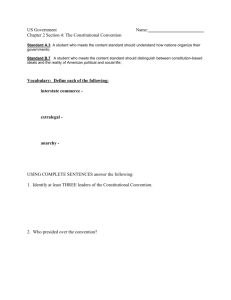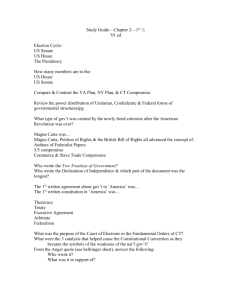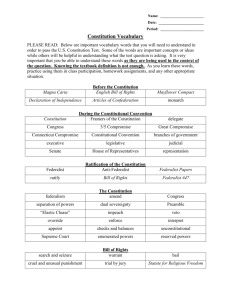File
advertisement
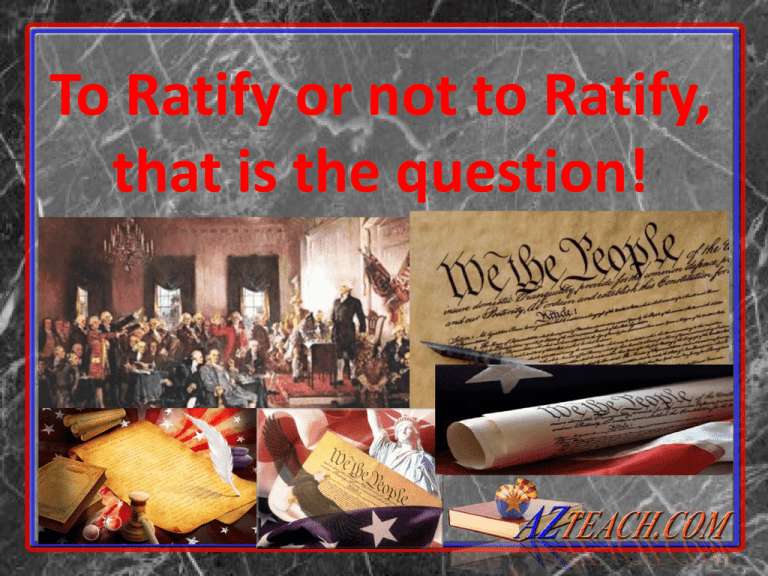
To Ratify or not to Ratify, that is the question! The Philadelphia Convention The U.S. Constitution was developed in 1787 at the Philadelphia Convention. Decide if each statement about the Convention below is true (T) or false (F). Rewrite any false statements to make them true. 1. 2. 3. 4. 5. 6. 7. ____ Delegates from all thirteen states attended the Philadelphia Convention. ____ Thomas Jefferson was the primary writer of the Constitution. ____ The Three-Fifths Compromise dealt with the question of how to count slaves for taxation and representation. ____ The New Jersey plan proposed that representation in a national legislature should be based on population. ____ Most delegates to the Convention were wealthy male landowners. ____ The discussions of the Philadelphia Convention were kept secret from the public. ____ Most delegates to the Convention had little political experience. • Constitutional Convention 55 delegates from 12 states meet ‘for the sole and express purpose of revising the Articles of Confederation’ – “the well-bred, the well-fed, the wellread, and the well-wed” – Average age is 42, 2/3 lawyers, 1/3 owned slaves – Had political experience, from cities • No Rhode Island, John Adams, Thomas Jefferson, Sam Adams, John Hancock, or Patrick Henry! • Father of the Constitution – James Madison of Virginia – Spoke over 200 times – Took extensive notes The Philadelphia Convention • Philosophy into Action – Human Nature • which is self-interested – Political Conflict • which leads to factions – Objects of Government • including the preservation of property – Nature of Government • which sets power against power so that no one faction rises above and overwhelms another Constitutional Conflict!!! • Virginia Plan Issues of Equality – Strong national government – Three branches of government • (legislative, executive, judicial) – Two houses of congress, based on population – Big states like it! • VA, Penn, NC, Mass, NY, MD JUST before was voted on, NJ introduced a new plan • New Jersey Plan – Three branches (same three) – ONE house – equal representation – Two executives Constitutional Compromise • Connecticut Compromise – Roger Sherman of Conn presents the compromise • House of Reps is based on population • Senate has two representatives per state (equal representation) – “Upon what principal shall the states be computed in representation?” • Gouverneur Morris • Issues of North v. South – South wanted slaves to be counted in population – Elbridge Gerry (Mass) said “Blacks are property and are used to the southward as horses and cattle to the northward” If you want slaves to count “make them citizens and let them vote.” Slavery and Representation • When Elbridge Gerry said “Blacks are property and are used to the southward as horses and cattle to the northward” If you want slaves to count “make them citizens and let them vote,” What was he saying??? Slavery and the Constitution • Issue of Slavery • Declaration of Independence is beginning to change people’s attitudes towards slavery • South Carolina and Georgia threatened to leave the Union • James Madison (Father of the Constitution) comes up with a compromise – 3/5 Compromise • Made a mockery of the Declaration • 3/5 of slaves were counted, for representation purposes • Ended the slave trade coming IN to the country in 20 years (1808) The Agenda in Philadelphia • The Individual Rights Issues – Some were written into the Constitution: • Prohibits suspension of writ of habeas corpus • No bills of attainder • No ex post facto laws • Religious qualifications for holding office prohibited • Strict rules of evidence for conviction of treason • Right to trial by jury in criminal cases – Some were not specified • Freedom of speech and expression • Rights of the accused The Madisonian Model • To prevent a tyranny of the majority, Madison proposed a government of: – Limiting Majority Control – Separating Powers – Creating Checks and Balances – Establishing a Federal System • Federalist Paper #51 The Madisonian Model • The Constitutional Republic – Republic: A form of government in which the people select representatives to govern them and make laws – Favors the status quo – change is slow • The End of the Beginning – The document was approved, but not unanimously. Now it had to be ratified. What about the Executive Branch? • Chief Executive – One? – Two?/Three? – How long should the President serve? • How to choose? – Congress picks the President? – People elect him? – Electors from each state? – Electoral College? Constitutional Convention: The Final Agreement The Executive • Single chief executive • Electoral College to keep Congress out – Clunky system – Intended to prevent the riff-raff from deciding election • 4-year term of office Electoral College • Has changed a lot since 1787 • Number of electors from each state determined by the number of Senators plus Representatives •Whoever gets 270, wins! Constitutional Change • The Informal Process of Constitutional Change – Judicial Interpretation • Marbury v. Madison (1803): judicial review – Changing Political Practice – Technology – Increasing Demands on Policymakers Ratification Anti-Federalist Ratify – to approve Federalist • Against the constitution • Supported the Constitution • Would create an overbearing & • In favor of ratifying overburdening central govt hostile to • From larger states, cities, merchants personal freedoms • Alexander Hamilton – Would ruin the country with taxes • James Madison – Wanted a Bill of Rights • John Jay • Giving up state power to Federal • John Adams Government made them uneasy • George Washington • Patrick Henry • Aaron Burr • Sam Adams • Thomas Jefferson The Difficult Road to Ratification • The Federalist Papers – Collaborative writing of Hamilton, Jay, and Madison – Series of 85 essays defending the Constitution and republican form of government – Considered the best political theorizing in the US • Anti-Federalist view – Such patriots as Samuel Adams and Patrick Henry – Const. a document written by aristocrats, for aristocrats – Would create an overbearing & overburdening central govt hostile to personal freedoms – Wanted a list of guaranteed liberties, or a bill of rights – Decried the weakened power of the states Federalists vs. Anti-Federalists • Federalist Papers – Written to support the ratification of the constitution – Written in newspapers by anonymous authors (mostly A. Hamilton, J. Jay, J. Madison) Federalists and Anti-Federalists The Federalists were people who supported ratification of the Constitution. The Anti-Federalists were people who opposed it. Below are arguments made by the Anti-Federalists against the Constitution. Under each one, explain in your own words how the Federalists countered this concern. 1. The national government would have too much power at the expense of the states. 2. There would be no protection of the individual rights of citizens against the government. 3. Congress could do anything with the Necessary and Proper Clause. 4. The president would be similar to a king. QUESTIONS???

